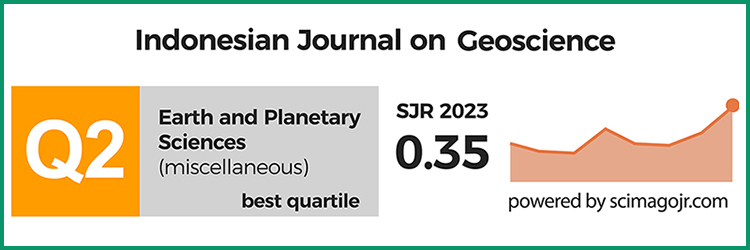Engineering Geological Investigation of Slow Moving Landslide in Jahiyang Village, Salawu, Tasikmalaya Regency
DOI:
https://doi.org/10.17014/ijog.7.1.27-38Keywords:
slow moving landslide, residual soil, rise of groundwater level, finite element methodAbstract
An understanding of landslide mechanism is imperative to determine the appropriate mitigation method. The slow moving landslide (creeping) which occurred in Kampung Salawangi, Jahiyang Village, Salawu Subregency, Tasikmalaya had caused economical and environmental losses due to the frequent active movement particularly following rainfall events. Engineering geological investigation and slope stability analysis were carried out in the studied area in order to elucidate the mechanism of the landslide. The engineering geological investigation consists of local topographical mapping, geotechnical drillings, hand borings, cone penetration, and laboratory tests. The slope stability assessment of the recent landslide was conducted by a finite element method. The results of engineering geological data analysis show that the studied area is composed of residual soils of soft to firm sandy silt and loose to compact silty sand and base rock of fresh to weathered volcanic breccias with groundwater level varying between 3 - 16 m. The engineering properties of the residual soils indicate that the sandy silt is of high plasticity and the shear strength properties of the sandy silt and silty sand show low value with effective cohesion of 6.0 - 21.74 kPa and effective friction angle of 12.00 - 25.980. The assessment of slope stability shows that the stability of the studied area is largely influenced by the rise of groundwater level marked by the decrease of safety factor and increase of slope displacement.
References
Bowles, J.E., 1989. Physical and geotechnical properties of soils. 2nd edition. McGraw-Hill Book Company, New York, N.Y., U.S.A., 576 pp.
Bowles, J. E., 1996. Foundation analysis and design. 5th edition. McGraw-Hill Book Company, New York, N.Y., U.S.A., 1175 pp.
British Standard 5930, 1999. Code for Practice for Site Investigations, British Standard Institution, London.
Budhitrisna, T., 1986. Geological Map of the Tasikmalaya Quadrangle, Jawa, scale 1 : 100.000. Geological Research and Development Centre, Bandung.
Cepeda, J., Smebye, H., Vangelsten, B., Nadim, F., and Muslim, D., 2010. Landslide Risk in Indonesia. Global assessment report on disaster risk reduction. United Nations, International Strategi for Disaster Reduction.
Gorog, P. and Torok, A., 2007. Slope stability assessment of weathered clay by using field data and computer modelling: a case study from Budapest. National Hazards and Earth System Sciences,7. p.417-422. doi:10.5194/nhess-7-417-2007
Meyerhoff, G.G., 1956. Penetration test and bearing capacity of cohesionless soils. Journal of Soil Mechanics and Foundations Division, ASCE, 82 (1) p. 1-19.
Pikiran Rakyat, 2007. Address: https://www.pikiran-rakyat.com/ access date: March 5, 2007.
Plaxis BV, 1998. Plaxis Finite Element Code for Soil and Rock Analysis, user’s manual. Plaxis BV, Delft, Netherlands. Pusat Vulkanologi dan Mitigasi Bencana Geologi, 2006.
Prakiraan Potensi Longsor di Pulau Jawa Bulan Januari 2006, https://portal.vsi.esdm.go.id/, access date: November 18, 2006.
Skempton, A. W., 1953. “The colloidal "activity" of clays.” Proceedings, 3rd International Conference of Soil Mechanics and Foundation Engineering, Zurich, 1, p.57-61.
Tohari, A., Soebowo, E., Rahardjo, P.P., Irianta, B., Daryono, M.R., Wardhana, D.D., Widodo, and Sukaca, 2006. Penelitian Kondisi Kestabilan Lereng Kupasan di Jalan Raya Cadas Pangeran, Desa Cigendel, Kecamatan Rancakalong, Kabupaten Sumedang. Laporan Teknis, Kegiatan Penelitian Pengkajian Teknologi Mitigasi Bencana, No.: 797D/IPK.1/OT/2006, Sub kegiatan 4977.0345, Pusat Penelitian Geoteknologi-LIPI.



















